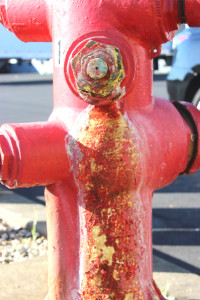“A leaky fire hydrant located on private property on Industrial Way was repaired by the city’s Public Works Department Tuesday,” Assistant City Manager Anne Cardwell said in a written statement Wednesday, “but not before drawing public ire for lack of a timely response.”
It was a repair, not merely a shutoff, so no connections were shut off to neighboring warehouses or other hydrants as some residents had feared, Cardwell said later by email to The Herald.
But the fix didn’t happen until a truck driver complained about the water waste to a Bay Area television station.
Others said they have complained about the hydrant near 363 Industrial Court, saying it has been leaking for several months to a year.
Cardwell confirmed there had been no attempt to capture the leaking water.
“Rather than make excuses for why it took so long to get this particular issue fixed, city staff reviewed our internal gaps in communication and procedures and immediately tightened up our policy to ensure that it does not happen again,” Kilger said in the statement.
“Our residents and customers deserve timely, consistent response times, especially given drought conditions, and we will ensure moving forward that they receive it.”
Graham Wadsworth, director of Public Works, told the television station Tuesday the hydrant has no meter, but he has estimated the loss at about 700 gallons a day.
If the leak has been going on for a year, that would be 255,500 gallons.
Benicia and California frequently measure water in acre-feet, the volume it takes to cover 1 acre to a 12-inch depth. One acre-foot contains 325,851 gallons.
Wadsworth said his department was told about the leak a month ago. Cardwell said the hydrant doesn’t have a conventional shut-off valve that would have ended the leak quickly.
Another complication is an ongoing dispute about who owns the hydrant.
The hydrant is on private property where warehouses have been built. The owner claims the city owns the hydrant, but city officials contend the hydrant belongs to the property.
Repair estimates range from $2,000 to $5,000, with the only other option being to shut off the water main that connects to the hydrant — as well as to other hydrants and to nearby warehouses.
This isn’t the first time Benicia has been criticized for water waste during California’s four-year drought.
Last August, one resident aired a 2010 report from the city to California that said Benicia couldn’t account for more than 25 percent of its drinking water after it leaves the municipal water treatment plant.
“We’re losing 23 billion gallons a year,” Jon Van Landschoot told the City Council during its public comment portion of a regular Council member.
At the time, Kilger blamed the apparent loss on outdated meters that don’t accurately measure water distribution to customers. Replacing those meters with new, accurate ones could cost the city between $3 million and $4 million.
In the meantime, the city also is searching out water line leaks.
Wadsworth also has blamed poorly performing meters, unmetered water, main breaks, hydrant shears and distribution system leaks for the so-called “lost water.”
Kilger said Benicia’s municipal government “has been very proactive in promoting water conservatin efforts, both within the city itself as well as in the community, as was recently illustrated when Benicia significantly exceeded the state-mandated targets for water conservation in April and May.”
To address the severe drought, the Council spent an additional $900,000 last year on water after the State Water Project, normally the source of 70 to 80 percent of the city’s water supply, announced that it would provide no more than 5 percent of the water for which contractors had paid.
Benicia annually contracts for 10,000 acre-feet, or 3.3 billion gallons.
The city can get by on 35 percent of its allocation, supplemented with water from the Solano Project supply in Lake Berryessa and, in emergencies, from Lake Herman.
The Council also has imposed outdoor water restrictions to reduce consumption and approved an emergency surcharge to help cover the fiscal costs of dealing with the drought.
In 2013, the base year California is using in demanding an overall cutback of 25 percent statewide, the average Benicia resident used from 72 gallons a day in January to 146 gallons a day in May, with consumption affected by rain and temperature.
By 2014, citywide consumption had dropped to a low of 58 gallons per person and a high of 120 gallons a day; overall the community had reduced its annual consumption rate by 31 percent by the end of last year.
City employees also are looking for funding sources to underwrite a way by which 2 million gallons of non-potable water from the city’s wastewater treatment plant could be delivered to Valero Benicia Refinery, which contracts for about half of the city’s water. At least $300,000 is needed for the preparatory work, such as environmental review and a market analysis.
Kilger and Cardwell said anyone who learns of a leak, pipe damage or other need for repair should call the Benicia Water Conservation Hotline, 707-746-4380, selecting Option 2, or call 707-746-4296 during non-business hours.
Reports also can be emailed to water@ci.benicia.ca.us.
“All calls will be returned within one business day, with repairs evaluated and prioritized in a maximum of 48 hours,” the two said in the prepared statement.
“The intention is to speed the process on both fronts, in terms of early identification of leaks and subsequent repairs.
“If leaks occur on private property or disputed property, the owners will be given 48 hours to fix the problem.”







Leave a Reply